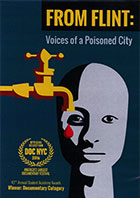
From Flint: Voices of a Poisoned City 2016
Distributed by The Video Project, 145 - 9th St., Suite 102, San Francisco, CA 94103; 800-475-2638
Produced by Liv Larsen
Directed by Elise Conklin
DVD , color, 25 min.
High School - General Adult
Activism, City Planning, Ecology, Environmentalism, Government, Industries, Law, Natural Resources, Public Health, Water Supply, Water Pollution
Date Entered: 03/14/2018
Reviewed by Joseph Baumstarck, Jr., University of Louisville, Southern Baptist Theological Seminary, Ivy Tech Community CollegeFrom Flint briefly documents the experiences of a small group of Flint, Michigan residents as they attempt to deal with the residential water contamination resulting from municipal governmental decisions. Flint’s local government decided to utilize the Flint River which runs through the town for its municipal water supply rather than pay a small increase in fees to continue to use the water it had been successfully piping in from Detroit for the past fifty years. Although this decision impacted almost all of the residents of Flint the documentary focused on a narrow spectrum of residents living in one neighborhood who suffered the most serious and longest lasting consequences. In the documentary residents and activists mentioned the massive global failure at all levels of government which allowed the water supply to become grossly contaminated and noted the massive cover-up which occurred following the disaster. Unfortunately the video does little to actually show where the problems occurred and although the documentary states a cover-up occurred there is little follow-through on this statement. The film reports that three government officials were charged, but does not further address these charges.
The documentary was put together by five graduate students from the University of Michigan as their thesis project. As a thesis project the film succeeds well, but does not adequately cover the situation for those who are not already familiar with the Flint water crisis. Most of the film involved coverage of several political meetings from late 2014 through 2015 which attempted to address the problems experienced by citizens from Flint. Seizures, rashes, problems effecting newborns and children, undrinkable water due to smell, contaminants, and particulates, lead poisoning affecting entire families, and the lack of potable water in some neighborhoods are documented in the film. Several self-help strategies engaged in by Flint residents to attempt to alleviate some of the problems are discussed with the participants. At a localized level these interviews are one of the highlights of the film.
Overall, the biggest negative for this documentary is the lack of scale. The area affected appears to be small and the number of affected people appears to be minimal. The film fails to address the massive scale of the problem. The overall video and sound quality are good. The documentary suffers from a lack of timing regarding what is shown and the correlation with the severity of problems. Several aspects of the film occupy a large percentage of the film, but do not address the more severe problems which are covered in brief glimpses. A rating of recommended is assigned due to the depiction of a culturally significant problem and some self-help strategies that appear to have been successful. Lack of scale and the lack of significant background information keep the rating from being higher. Unfortunately this film is unlikely to be widely viewed in areas outside of Flint, with the exception of specialized viewers involved with municipal water supplies, municipal government, and water ecology.
Awards
- 1st Place College Documentary, Flint Youth Film Festival 2016
- Student Academy Award, Academy of Motion Picture Arts and Sciences